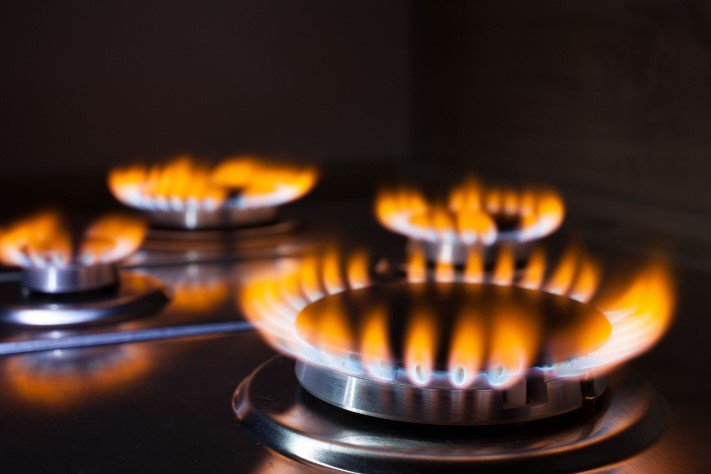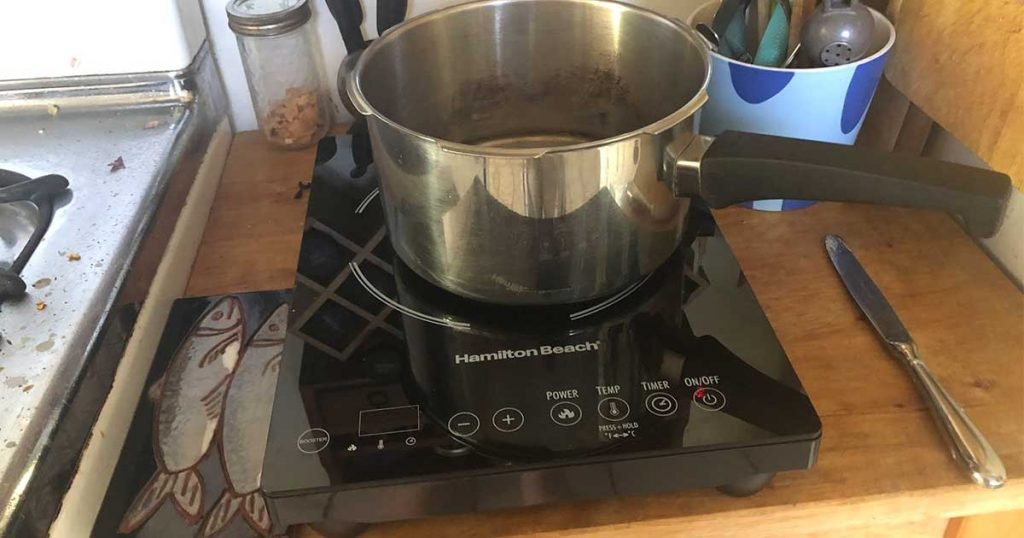If you’ve noticed your gas stove burner flames looking a bit colored lately, don’t panic. I know an unusual orange flame on that stove is definitely cause for concern. With a few troubleshooting tips, I can walk you through getting those flames back to their nice, normal blue color.
Let me break down what causes orange gas flames, whether it’s a serious safety issue, and the steps you can take to fix it.
What Can You Do to Fix an Orange Flame From Your Gas Stovetop?
If those flames on your gas range are looking more like a sunset than ocean blue, some troubleshooting is in order. Here are the steps you can take to get to the bottom of an orange gas flame and fix the issue:
- Clean the burners thoroughly, especially any blocked burner ports. Food drips, grease splatter, and other gunk can gradually clog the tiny gas ports, obstructing smooth gas flow for complete combustion. Scrub the burners and use a straightened paper clip or needle to gently clear any debris from the ports.
- Adjust the air shutters or air-gas mixture settings on the burners if your stove is equipped with these. Opening air shutters or mixture screws allows more oxygen to reach the flame, encouraging thorough burning and bluer flames. Consult your owner’s manual.
- Have a technician check your gas line pressure. Insufficient incoming gas pressure can lead to incomplete combustion and orange flames. They can assess if pressure is in the proper 7-14 inch WC range for natural gas or 11-14 inches for propane.
- If flames stay orange after cleaning and air mixture adjustments, the burner itself might be defective. Components like the gas ports, venturi tubes or orifices may be damaged or corroded over years of use. Replacing the faulty burner should restore proper performance.
- Consider replacing old gas supply lines if significant internal corrosion is restricting gas flow. A technician can determine if replacements are needed. Both DIY or professional line replacements are options if corrosion is causing flow problems.
- Install carbon monoxide detectors for extra safety if orange flames persist after cleaning and repairs. The CO monitors serve as a warning if incomplete combustion is still occurring.
What causes an Orange Flame on a Gas Stove?

If your gas range’s burners have turned an ominous orange color, what’s behind it? Here are the most common causes of orange gas flames:
- Blocked burner ports – Leftover food particles, grease, and grime can gradually clog the tiny gas ports on stove burners. This debris obstructs smooth gas flow out of the ports, resulting in inefficient, incomplete combustion and air-starved orange flames.
- Dusty burners – Heavy dust and debris buildup on the exterior of the burners can also interfere with proper air access, potentially causing flames to burn orange. Keeping burners clean prevents this.
- Incorrect air mixture – Gas burners rely on a precise balance of gas and airflow for clean, stable combustion. If air openings get blocked or improperly adjusted, too little oxygen reaches the gas, resulting in orange, sooty flames.
- Low gas pressure – Insufficient gas line pressure leads to the burner crimping its firepower. Low input gas volume paired with sufficient air intake makes it hard to sustain complete clean combustion, so longer orange flames result.
- Defective burner – Over time, wear and tear on a burner can deform or corrode the delicate gas ports, venturi tubes, and air mix components. This alters the gas-air ratio and allows orange burning. Replacing the damaged burner is the fix.
- Old pipes – Corrosion and buildup inside aged gas supply pipes and valves can constrict gas flow. This starvation of gas mimics low pressure and creates inefficient orange flames.
Why Should You Fix the Orange Flame in the First Place?
Take it from my experience – properly adjusted clean blue gas flames lead to tastier home-cooked meals, lower utility bills, and safer operation. Making the effort to fix orange flames and clicking when off pays dividends! I know, it might seem harmless or like something you can live with. But there are some compelling reasons to address an orange gas flame promptly beyond just the safety concerns:
- Blue flames properly utilize all the gas by allowing thorough, complete combustion. This means your stove is running at maximum efficiency with no wasted fuel.
- Orange flames may cause your gas bills to run higher over time. The incomplete combustion requires more volume of gas flow to generate heat, increasing costs.
- Food will cook more evenly and reliably over consistent blue flames. The orange flame’s erratic heat output leads to hot and cold spots.
- There’s great peace of mind knowing your gas appliance’s combustion is optimized and operating safely once the flame is restored to blue. Having carbon monoxide detectors adds another layer of protection.
- Your gas appliances will last longer without the strain of partially blocked or overworked burners forcing orange flames. It reduces wear and tear.
What are the Signs of Burner Issues Causing Orange Flames?
Along with the orange color itself, here are some other clues that your gas stove’s burners may have underlying issues contributing to improper combustion:
- Weak, jumping, or uneven flame appearance, especially at higher heat settings
- Hissing, popping, or whistling sounds from the burners
- Soot buildup on cookware, grates, or stove surfaces
- Food takes much longer to cook or doesn’t brown evenly
- Burners ignite slowly, erratically, or fail to light
- Flames lift off or hover over the burner instead of sitting flush
- Burners have yellow tips or Match flame color.
- Strong gas odor with pilot lights on
- Evidence of scorching under cookware
Should You Be Worried? Is the Orange Flame Dangerous?
According to the American Gas Association, over 40% of homeowners unknowingly have gas appliance issues, and is even considering banning them altogether. While unnerving, an orange stove flame isn’t necessarily an immediate threat if temporary. But prolonged orange flames should be addressed because:
- The excess gas indicates inefficient, incomplete combustion.
- More carbon monoxide may be generated, which is odorless and deadly.
- Excess gas flow could ignite or explode if concentrated.
- Appliances won’t heat properly, cook evenly, or ignite reliably.
The Bottom Line
Seeing orange gas flames at low settings may not be a dire warning. But make it your mantra: when in doubt, check it out. With a bit of DIY care, those frustrating flames can be brought back to bright proper blue in no time – and more importantly, safely. Your cooktop will thank you!
Common Questions
Why did my gas stove flame turn orange?
Common causes include blocked burner ports, low gas pressure, incorrect air mixture, a defective burner, dusty buildup, or corroded gas lines. This leads to incomplete combustion.
Is it safe to use my stove with orange flames?
It’s not recommended. Prolonged orange flames indicate improperly burning gas, which can generate dangerous carbon monoxide. Have the stove serviced promptly
How can I get the flames back to blue?
Clean the burners thoroughly, adjust air shutters, have technicians check gas pressure, replace defective burners, or replace corroded gas lines, as needed.
Should I call a technician for orange flames?
If DIY troubleshooting doesn’t reveal the cause or fix the problem, calling a technician to inspect for issues like low gas pressure, defective burners, or leaks in gas lines is the next step.



